Easy to Draw Ra the Sun God of Egypt
Egyptian Gods

Ancient Egyptian Gods and Goddesses
For all ancient people, the world was filled with mystery. Much of what they experienced in the world around them was unknowable and frightening. The ancient Egyptian gods and goddesses represented aspects of the Egyptians' natural and "supernatural" surroundings and helped them understand its many aspects.

Demons
Demons were more powerful than human beings but not as powerful as gods. They were usually immortal, could be in more than one place at a time, and could affect the world as well as people in supernatural ways. But there were certain limits to their powers and they were neither all-powerful nor all knowing. Among demons the most important figure was Ammut – the Devourer of the Dead – part crocodile, part lioness, and part hippopotamus. She was often shown near the scales on which the hearts of the dead were weighed against the feather of Truth. She devoured the hearts of those whose wicked deeds in life made them unfit to enter the afterlife. Apepi, another important demon, (sometimes called Apophis) was the enemy of the sun god in his daily cycle through the cosmos, and is depicted as a colossal snake.
Ancient Egyptian Gods and Goddesses
Most Egyptian gods represented one principle aspect of the world: Ra was the sun god, for example, and Nut was goddess of the sky. The characters of the gods were not clearly defined. Most were generally benevolent but their favor could not be counted on. Some gods were spiteful and had to be placated. Some, such as Neith, Sekhmet, and Mut, had changeable characters. The god Seth, who murdered his brother Osiris, embodied the malevolent and disordered aspects of the world.
The physical form taken on by the various Egyptian gods was usually a combination of human and animal, and many were associated with one or more animal species. And an animal could express a deity's mood. When a god was angry, she might be portrayed as a ferocious lioness; when gentle, a cat. The convention was to depict the animal gods with a human body and an animal head. The opposite convention was sometimes used for representations of a king, who might be portrayed with a human head and a lion's body, as in the case of the Sphinx. Sphinxes might also appear with other heads, particularly those of rams or falcons.
Many deities were represented only in human form. Among these were such very ancient figures as the cosmic gods Shu of the air, Geb of the earth, the fertility god Min, and the craftsman Ptah. There were a number of minor gods that took on grotesque forms, including Bes, a dwarf with a mask-like face, and Taurt, a goddess whose physical form combined the features of a hippopotamus and a crocodile.
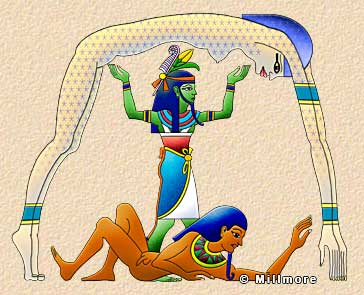
Nut, Shu and Geb
Nut was the mother of Osiris, Isis, Seth, and Nephythys, Nut is usually shown in human form; her elongated body symbolizing the sky. Each limb represents a cardinal point as her body stretches over the earth. Nut swallowed the setting sun (Ra) each evening and gave birth to him each morning. She is often depicted on the ceilings of tombs, on the inside lid of coffins, and on the ceilings of temples.
Shu was the husband of Tefnut and the father of Nut and Geb. He and his wife were the first gods created by Atum. Shu was the god of the air and sunlight or, more precisely, dry air and his wife represented moisture. He was normally depicted as a man wearing a headdress in the form of a plume, which is also the hieroglyph for his name.
Shu's function was to hold up the body of the goddess Nun and separate the sky from the earth. He was not a solar deity but his role in providing sunlight connected him to Ra. Indeed, he was one of the few gods who escaped persecution under the heretic king Akhenaten.
Geb was the father of Osiris, Isis, Seth, and Nephythys, and was a god without a cult. As an Earth god he was associated with fertility and it was believed that earthquakes were the laughter of Geb. He is mentioned in the Pyramid Texts as imprisoning the buried dead within his body.
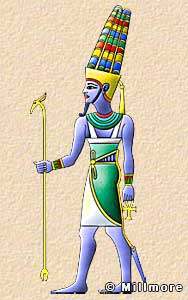 Amun
Amun
Also Known as Amen, Amun, Ammon
Amun was the chief Theban deity whose power grew as the city of Thebes grew from an unimportant village, in the old Kingdom, to a powerful metropolis in the Middle and New Kingdoms. He rose to become the patron of the Theban pharaohs and was eventually combined with sun god, Ra who had been the dominant deity of the Old Kingdom to become Amun-Ra, King of the Gods and ruler of the Great Ennead.
Amun's name means "Hidden One, Mysterious of Form," and although he is most often represented as a human wearing a double plumed crown, he is sometimes depicted as a ram or a goose. The implication is that his true identity can never be revealed.
Karnak was Amun's chief temple, but his fame extended well beyond the boundaries of Egypt. His cult spread to Ethiopia, Nubia, Libya, and through much of Palestine. The Greeks thought he was an Egyptian manifestation of their god Zeus. Even Alexander the Great thought it worthwhile consulting the oracle of Amun.

Anubis
Protector of the Dead
Anubis is shown as a jackal-headed man, or as a jackal. His father was Seth and his mother Nephythys. His cult center was Cynopolis, now known as El Kes. He was closely associated with mummification and as protector of the dead. It was Anubis who conducted the deceased to the hall of judgment.

Egyptian Hieroglyphs for Windows and MAC

Bastet
Bastet is depicted as a woman with a cat's head or simply as a cat. Originally an avenging lioness deity, she evolved into a goddess of pleasure.
Her cult center was in the town of Bubastis in the Western delta. Many cats lived at her temple and were mummified when they died. An immense cemetery of mummified cats has been discovered in the area.
 Bes
Bes
Unlike the other gods, Bes is represented full face rather than in profile, as a grotesque, bandy-legged, dwarf with his tongue sticking out. He was associated with good times and entertainment, but was also considered a
guardian god of childbirth. Bes chased away demons of the night and guarded people from dangerous animals.
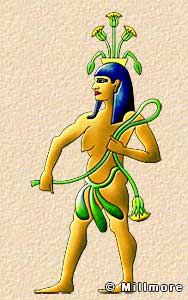 Hapi
Hapi
Hapi was not the god of the river Nile but of its inundation. He is represented as a pot-bellied man with breasts and a headdress made of aquatic plants. He was thought to live in the caves of the first cataract, and his cult center was at Aswan.
 Hathor
Hathor
Hathor was the daughter of Ra and the patron goddess of women, love, beauty, pleasure, and music. She is depicted in three forms; as a cow, as a woman with the ears of a cow, and as a woman wearing the headdress of a cow's horns. In this last manifestation, she holds the solar disc between her horns. She was the consort of Horus, and her name actually means "House of Horus." She had many temples the most famous of which is at Dendara.
There was a dark side to Hathor. It was believed that Ra sent her to punish the human race for its wickedness, but Hathor wreaked such bloody havoc on earth that Ra was horrified and determined to bring her back. He tricked her by preparing vast quantities of beer mixed with mandrake and the blood of the slain. Murdering mankind was thirsty work, and when Hathor drank the beer she became so intoxicated that she could not continue her slaughter.
Each year the goddess Hathor visited her husband the god Horus at Edfu temple to celebrate the feast of the Divine Union

 Horus
Horus
Horus was the son of Osiris and Isis and the enemy of the wicked God Seth. He is depicted as a hawk or as a man with the head of a hawk. Sometimes he is shown as a youth with a side lock, seated on his mother's lap. He was the god of the sky and the divine protector of kings.
Horus was worshipped throughout Egypt and was particularly associated with Edfu, the site of the ancient city of Mesen, where his temple can still be seen.
There are many stories of his wars against his uncle Seth, who murdered his father and usurped the throne. Eventually Horus defeated Seth and became the king of Egypt.
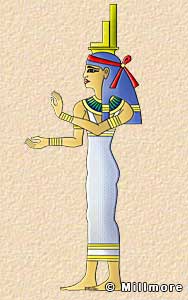 Isis
Isis
A very important figure in the ancient world, Isis was the wife of Osiris and mother of Horus. She was associated with funeral rites and said to have made the first mummy from the dismembered parts of Osiris. As the enchantress who resurrected Osiris and gave birth to Horus, she was also the giver of life, a healer and protector of kings.
Isis is represented with a throne on her head and sometimes shown breastfeeding the infant Horus. In this manifestation she was known as "Mother of God." To the Egyptians she represented the ideal wife and mother; loving, devoted, and caring.
Her most famous temple is at Philae though her cult spread throughout the Medi-terranean world and, during the Roman period, extended as far as northern Europe. There was even a temple dedicated to her in London.
 Khepre
Khepre
Also known as, Khepri, Khepra, Khepera, Khepre was a creator god depicted as a Scarab beetle or as a man with a scarab for a head. The Egyptians observed young scarab beetles emerging spontaneously from balls of dung and associated them with the process of creation. Khepre was one of the first gods, self-created, and his name means "he who has come into being," Atum took his form as he rose out of the chaotic waters of the Nun in a creation myth. It was thought that Khepre rolled the sun across the sky in the same way a dung beetle rolls balls of dung across the ground.
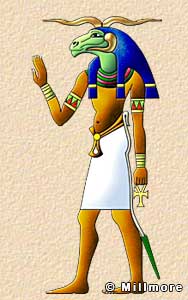 Khnum
Khnum
Khnum, was depicted as a ram-headed man. He was a god of the cataracts, a potter, and a creator god who guarded the source of the Nile,. His sanctuary was on Elephantine Island but his best-preserved temple is at Esna. The "Famine Stele", which is a carved stone tablet, contains appeals to Khnum during a famine caused by a low inundation of the Nile.
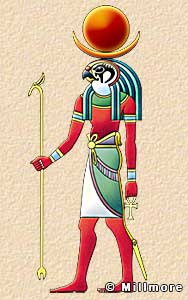 Khonsu
Khonsu
Also known as Khons Khensu, Khuns
Khonsu was the son of Amun and Mut, with whom he formed the Theban triad. He was a moon god depicted as a man with a falcon-head wearing a crescent moon headdress surmounted by the full lunar disc. Like Thoth, who was also a lunar deity, he is sometimes represented as a baboon. Khonsu was believed to have the ability to drive out evil spirits. Rameses II sent a statue of Khonsu to a friendly Syrian king in order to cure his daughter of an illness.
His temple was within the precincts of Karnak.
 Ma'at
Ma'at
Ma'at was the goddess of truth and justice, embodying the essential harmony of the universe. She was depicted as a seated woman wearing an ostrich feather, or sometimes just as the feather itself. Her power regulated the seasons and the movement of the stars. Ma'at was the patron of justice and the symbol of ancient Egyptian ethics, so the Vizier who was in charge of the Law Courts went by the title Priest of Maat.
Ma'at was the ultimate judge in the afterlife, and the heart of the newly deceased was weighed against her feather in the Hall of Two Truths. Ammut, devourer of the dead, ate those who failed her test.
 Montu
Montu
Montu was a warrior god who rose to become the state god during the 11th dynasty. He was associated with king Montuhotep I ("Montu is satisfied"), who reunited Upper and Lower Egypt after the chaos of the First Intermediate Period.
During the Twelfth Dynasty Montu was displaced by the rise of Amun, but he took on the true attributes of a war god when warrior kings such as Thutmose III and Rameses II identified themselves with him.
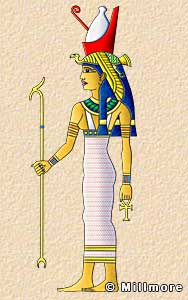 Mut
Mut
Mut formed part of the Theban Triad. She was one of the daughters of Ra, the wife of Amun, and mother of Khonsu. She was the Vulture goddess and is often depicted as a woman with a long, brightly colored dress and a vulture headdress surmounted by the double crown. In her more aggressive aspect she is shown as a lion-headed goddess.
Like Isis and Hathor, Mut played the role of divine mother to the king. Her amulets, which depict her as a seated woman suckling a child, are sometime confused with those of Isis.
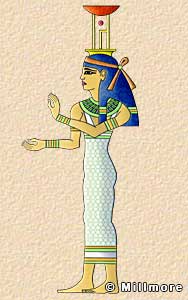 Nephythys
Nephythys
Daughter of Geb and Nut, sister of Isis, wife of Seth and mother of Anubis, Nephythys is depicted as a woman with the hieroglyphs for a palace and 'Neb' (a basket) on her head. She is thus known as "Lady of the Mansions" or "Palace." Nephythys was disgusted by Seth's murder of Osiris and helped her sister, Isis, against her husband, Seth. Together with Isis she was a protector of the dead, and they are often shown together on coffin cases, with winged arms. She seems to have had no temple or cult center of her own.
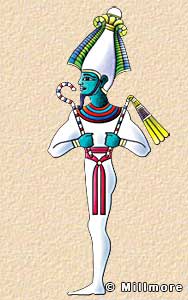 Osiris
Osiris
Osiris was originally a vegetation god linked with the growth of crops. He was the mythological first king of Egypt and one of the most important of the gods. It was thought that he brought civilization to the race of mankind. He was murdered by his brother Seth, brought back to life by his wife Isis, and went on to become the ruler of the underworld and judge of the dead.
He is usually depicted as a mummy holding the crook and flail of kingship. On his head he wears the white crown of Upper Egypt flanked by two plumes of feathers. Sometimes he is shown with the horns of a ram. His skin is depicted as blue, the color of the dead; black, the color of the fertile earth; or green, representing resurrection.
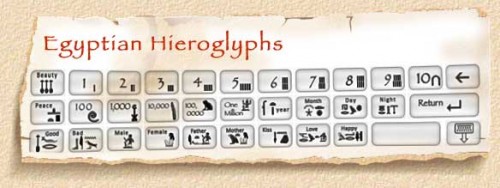 Osiris's head was thought to have been buried at Abydos, his main cult center. Each year, during his festival, there was a procession and a reenactment of his story in the form of a mystery play.
Osiris's head was thought to have been buried at Abydos, his main cult center. Each year, during his festival, there was a procession and a reenactment of his story in the form of a mystery play.
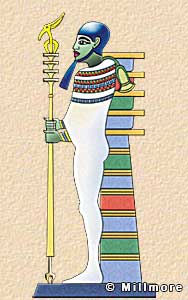 Ptah
Ptah
Ptah was a creator god, said to have made the world from the thoughts in his heart and his words. He was depicted as a mummy with his hands protruding from the wrappings and holding a staff. His head was shaven and he wore a scull cap. Ptah was associated with craftsmen, and the High Priest of his temple at Memphis held the title Great Leader of Craftsmen.
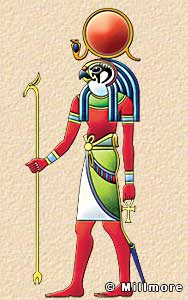 Ra
Ra
Also known as Re
The supreme sun god was represented as a man with the head of a hawk, crowned with a solar disk and the sacred serpent. However, in the underworld through which he passes each night, he is depicted as ram-headed.
Each day Ra traveled across the sky in the form of the sun, riding in his solar boat, and each night he journeyed through the underworld where he defeated the allies of chaos. He was reborn each morning in the form of the sunrise. His influence on the other gods was so strong that he subsumed many of their identities. Thus Amun became Amun-Ra, Montu became Montu-Ra and Horus became Ra-Horakhty. Pharoah Akenaten's god, the Aten, was another form of Ra, the solar disk.
The Egyptian kings claimed to be descended from Ra, and called themselves "The Son of Ra." His cult was very powerful during the period of the Old Kingdom,when Sun Temples were built in his honor. His cult center was at Heliopolis, which nowadays is covered by the northern suburbs of Cairo.
 Sobek
Sobek
Sobek was a crocodile god, depicted as a crocodile on an altar or as a man with a crocodile head wearing a headdress in the form of the sun disk with upright feathers and horns. Sobek's main cult centers were at Medinet el Fayum and at the temple of Kom Ombo, which he shared with Horus and which still exists today. There was a pool at Kom Ombo containing sacred crocodiles and it is still possible to see original mummified crocodiles at the temple.
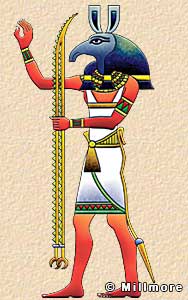 Seth
Seth
Also known as Set, Setekh, Suty and Sutekh
Seth was the son of Geb and Nut, and the evil brother of Osiris. He was the god of darkness, chaos, and confusion, and is represented as a man with an unknown animal head, often described as a Typhonian by the Greeks who associated him with the god Typhon. He is sometimes depicted as a hippopotamus, a pig, or a donkey. Seth murdered his brother and usurped the throne of Egypt and most of the other gods despised him.
Horus eventually defeated Seth, but it was thought that their battle was an eternal struggle between good and evil. Although Seth failed to keep the throne of Egypt he continued to be a companion of Ra. He sometimes accompanied Ra across the sky in his solar boat, causing storms and bad weather.
Seth was venerated by some, and his main cult center was at Naqada. Some kings would liken themselves to Seth in battle, but for the most part the people loathed him and his defeat by Horus was regularly celebrated.
 Tefnut
Tefnut
Tefnut was the wife of Shu and mother of Nut and Geb. She and her husband were the first gods created by Atum. She was the goddess of moisture or damp, corrosive air, and was depicted either as a lioness or as a woman with a lioness's head.
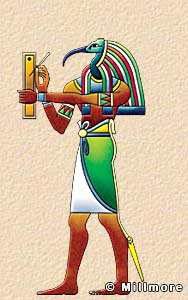 Thoth
Thoth
Thoth was the god of writing and knowledge, and was depicted as a man with the head of an ibis holding a scribe's pen and palette, or as a baboon. The Greeks associated him with Hermes and ascribed to him the invention of all the sciences as well as the invention of writing. He is often portrayed writing or making calculations.
Thoth stands apart from most of the other gods. He was as old as the oldest gods and often acted as an intermediately between gods. He was associated with the moon, and is sometimes shown wearing a moon disk and crescent headdress. One of his most important roles was to record the deeds of the dead at the day of their judgment and is often seen doing this in the Book of the Dead. His main temple was at Hermopolis in Middle Egypt.
![]()
Egyptian Hieroglyphics 2018
This is a brand new version that now works on Windows 10, MAC, iPad, Android and all mobile phones.
There are more than 1100 Hieroglyphic illustrations including 450 Egyptian word examples and over 650 hieroglyphs from the Gardiner list.
Egyptian Hieroglyphics includes detailed information on the history of Egyptian writing and mathematics, the use of the different types of symbols, how to write your name, how to recognize kings names and the story of the scribe with a video showing how papyrus is made.
All the content can be printed including typewriter and calculator functions.
There are also navigation and search text functions.
The Hieroglyphic Typewriter and Math Calculator is included.
The Hieroglyphic Typewriter and Math Calculator is included.The on screen QWERTY keyboard incorporates alphabet and number symbols together with a selection of determinative signs. The keys include Latin symbols together with their hieroglyph equivalents and descriptions, which allow you to type messages naturally and at a glance see the translations.
Kids can quickly write names and short secret messages and then select print from the menu.
Ancient Egyptian Gods and Goddesses
Source: https://discoveringegypt.com/ancient-egyptian-gods-and-goddesses/
0 Response to "Easy to Draw Ra the Sun God of Egypt"
Post a Comment